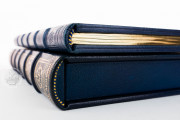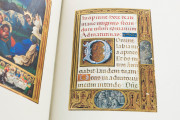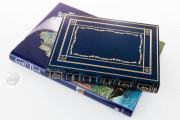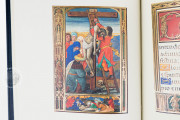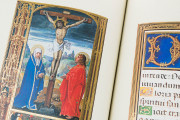The Golf Book is one of the most delightful Renaissance manuscripts from Belgium. The codex, written and illuminated in Bruges during the second quarter of the sixteenth century, features twenty-one superbly illustrated full-page miniatures, a calendar, and over forty historiated borders by the hand of one of the most renowned Flemish artists, Simon Bening.
Full-page Illustrations of Renaissance Sports Activities
Written in Latin, the Golf Book is certainly a fascinating book as it displays a collection of sports activities and pastimes typical of the period in which the manuscript was created. Its title is the result of a miniature on fol. 27r (a calendar page of the month of September) where four men are depicted while playing a game that resembles golf.
It is worth mentioning that the pages are not in their original order, for, originally, there would have been the calendar, followed by the book of hours, and finally the miniature of Boniface of Lausanne, which is now on fol. 1r.
Grisaille Decorations by Simon Bening
In addition to the full-page miniatures, the iconography of the Golf Book incorporates other types of illustrations, especially along the borders, such as medallions, architectonic decoration, and cameos in which Simon Bening applied the grisaille and semi-grisaille technique, that is, the use of different shades of grey.
Although only twenty-three pages of the manuscript remain, they are certainly enough to identify the hand that created such a remarkable iconographic apparatus. The fine illustrations are the work of Simon Bening, son of Alexander Bening, and his workshop in Bruges where he finally settled in around 1519.
A Beautiful Example of Gothic Script
The Book of Golf exhibits a superb example of Gothic script and appears to have been made for a Swiss patron, as the presence of the miniature of Boniface of Lausanne seems to suggest. What is certain is that the codex ended up among the possessions of Ernst von Pöllnitz (1813-1900), Chamberlain of Ludwig I of Bavaria, and of Duke Albert of Saxe-Coburg-Gotha, the curator and historian who owned it before selling it to the British Museum on April 13, 1861.
Binding description
Binding
Like many medieval manuscripts the Golf Book lost its original binding, which was replaced with a eighteenth-century German one featuring velvet and metalwork. The manuscript now displays a British Museum in-house binding with gauffered and gilt edges, dated 1927.
We have 1 facsimile edition of the manuscript "Golf Book (Book of Hours)": Libro del Golf facsimile edition, published by M. Moleiro Editor, 2004
Request Info / Price







